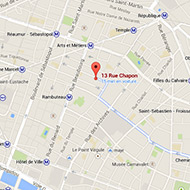The series of photographs by Eric Rondepierre called ?DSL?(1) offers us images whose process is not unlike some previous series by the artist. Except that ? DSL deformations,? according to Etienne Hatt (2), ?are no longer alterations of film material as in Précis de décomposition (1993-1995) or Moires (1996-1998), but glitches, brief disruptions of the digital stream. Images are frozen or collide, forms distend or blur. In DSL 13, a landscape takes the silhouette of a car, in DSL 17, Audrey Hepburn comes up against her transparent double. The entire series has a pictorial character. Pixel trails seem like touches of paint. Rondepierre, who was a painter before becoming a photographer, claims so. He says make paintings but simply biding one?s time .?
The connection with painting is also noted by Catherine Millet: ?This series entitled DSL is the most ?pictoral? of the whole work ... Mottling of colour, ?Cézannian? splitting of pixels, ?futuristic? decomposition of movements, marshmallow faces that stretch and distort as much as under the indolent brush of Glenn Brown.? (3)
One can also compare these images of more archaic mediums, as Dominique Païni does: ?In these times of generalised virtualisation of still and moving images, this fusional encounter, which some might consider against nature, between film, television and computing offers an unexpected legacy of the art of stained glass or, better yet, of mosaic.? (4)
However ? and this is one of the many paradoxes in the work of Eric Rondepierre ? these ?vitrified shivers? (5) that seem to refer us to old manual techniques are obtained by equipment of contemporary techniques, and the procedure of direct sampling which he has adopted since his beginnings is exercised at the expense of a virtual image - by a screenshot (and not by filming). Having cinematographic origins, this arrives on all computers via internet TV. True to the state of mind which oversees his first diversions, DSL pertains to what the artist spoke about in 2003: La Revanche du spectateur (Revenge of the Spectator) (6).
In an interview with Julien Milly, he states: ? it?s pretty close to what might be called, with Michel de Certeau, consumer production, the nocturnal background of social activity. I am a ?user? of DSL, that is to say ?dominated? by the totalitarian expansion of the iconosphere. However, active and unruly, I found my revenge in a tiny flaw, where I can ?tinker?, sabotage, reclaim something. (...) I know that my life is controlled even in the most intimate details, but I also know that I still have this illusion, this small parcel, this small crumb of time which I reclaim without risk, because I project it into the field of art, which is itself dependent on these devices. (...) But, as Agamben, who you cited earlier, says : ?The more devices are pervasive and disseminate their power in every area of our lives, the more the government is faced with an elusive element that seems to particularly shirk its decision which it submits to docilely.? (7)
(1) DSL = Digital Subscriber Line. Series begun in 2011, part of which was exhibited in the retrospective dedicated to him by the Maison Européenne de la Photographie in February 2015
(2) ?Eric Rondepierre, au film de la vie?, in Artpress, No. 418 (January 2015), pp. 48-52
(3) Catherine Millet, ?La Nuit du chasseur d?images?, in Images secondes, Editions Loco, 2015
(4) ?Digitale mosaïque? in Désolé de saboter vos lignes (exhibition catalogue of the Arsenal of Metz), Editions Filigranes, 2012
(5) Dominique Païni, Op. Cit.
(6) ?La revanche du spectateur? in Eric Rondepierre, Editions Leo Scheer, 2003, p.175
(7) The Voyeur, entretien avec Julien Milly, Editions de l?incidence, 2015, p.122


